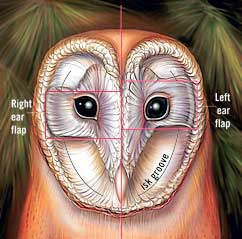Owls!
 |
| Scary owl! Grrr...ok probably more cute than scary so you'll just have to use your imagination. |
In fact, owls are so quiet and precise, that they are like the stealth bombers of the avian world (pew pew pew!). Their feathers have evolved to do some particularly cool things, like turn their faces into satellite dishes. No, seriously, that distinctive feather pattern around their face channels sound directly to their ears, which are just slightly to the outside of their eyes.
 |
| Owl face feathers act like satellite dishes! |
Warning! Opinion!
At this point it is pertinent to make a very brief asside regarding experimental ethics. How did the study authors discover that the face feathers of the owls worked to funnel sound into their ears? They plucked the poor buggers and watched them try to find food. Oddly enough they weren't able to do it very well. For me, this experiment crosses the line of what we need to know vs. the animal's welfare. Even as a passable acoustician, I could probably model the whats going on. So, I think there are likely better ways to go about answering that question. Regardless, what's done is done and I probably wouldn't be sharing this post if the original work hadn't been published. |
| #ThingsThatMadeItPastTheEthicsCommittee. Actually, I think these are chicks being rehabilitated, not experimental subjects. |
 |
| Warranted experiment? |
We apologize for this brief interruption and now return you to the facts
Another cool thing about owls is how they can localize sound in their environment. As humans, we can do this to a limited extent- we can tell whether a sound is coming from the left or right. Our brains do this by interpreting the very slight delay that results from the time it takes for a sound wave to hit one ear and then the other.
 |
| Humans can tell which direction a sound is coming from by subconsciously measuring the time difference between Chumba Wumba reaching one ear and the other. Possibly works for other sound sources too. |
If you want to test this out, try blindfolding yourself and having a friend (or hired professional) stand in front of you and clap. Close your eyes and try to point to where the sound is coming from. Then have them move up and down, you should find it more difficult to tell whether a sound is coming from above or below you. As you can see, there has been no evolutionary pressure to gain the ability for up-down sound orientation- we just can't do it very well. In fact, people with the ear structures describe below would likely face negative sexual selection (e.g. nobody would date them. Awww sad face.. :( )
However, because owls need to find prey, avoid objects and evade other predators all in the dead of night they need to localize sound in 3-dimensions. And that is where things get freaky. Owls ears have slowly migrated to different heights on their skull.
 |
| More accurate representation of The Great Owl... Somehow the illustrators weren't sold on my edits... |
By having one ear higher than the other they can determine (based on the time delays) where the sound is coming from in the vertical and horizontal directions! So freaking cool. I think the next designer surgery should be to move ears in the vertical dimension. I know a few crazy birders that would really appreciate that skill!
 |
| A real diagram of owl ears from a cool website all about owls. Go check it out! Owl ears and Eyes |
Anyway, there are lots of other cool things about owls including how their feathers act to silence their flight as they zone in for the kill as well as the interesting sounds they make. Go check them out!
Thanks for reading and have a happy H-OWL-oween!!
Love the post and the blog as a whole! Can we repost a link on our fb/twitter? --Nicole from Wildlife Acoustics
ReplyDeleteI think learning about how owls use their feathers for hearing is fascinating.
ReplyDelete